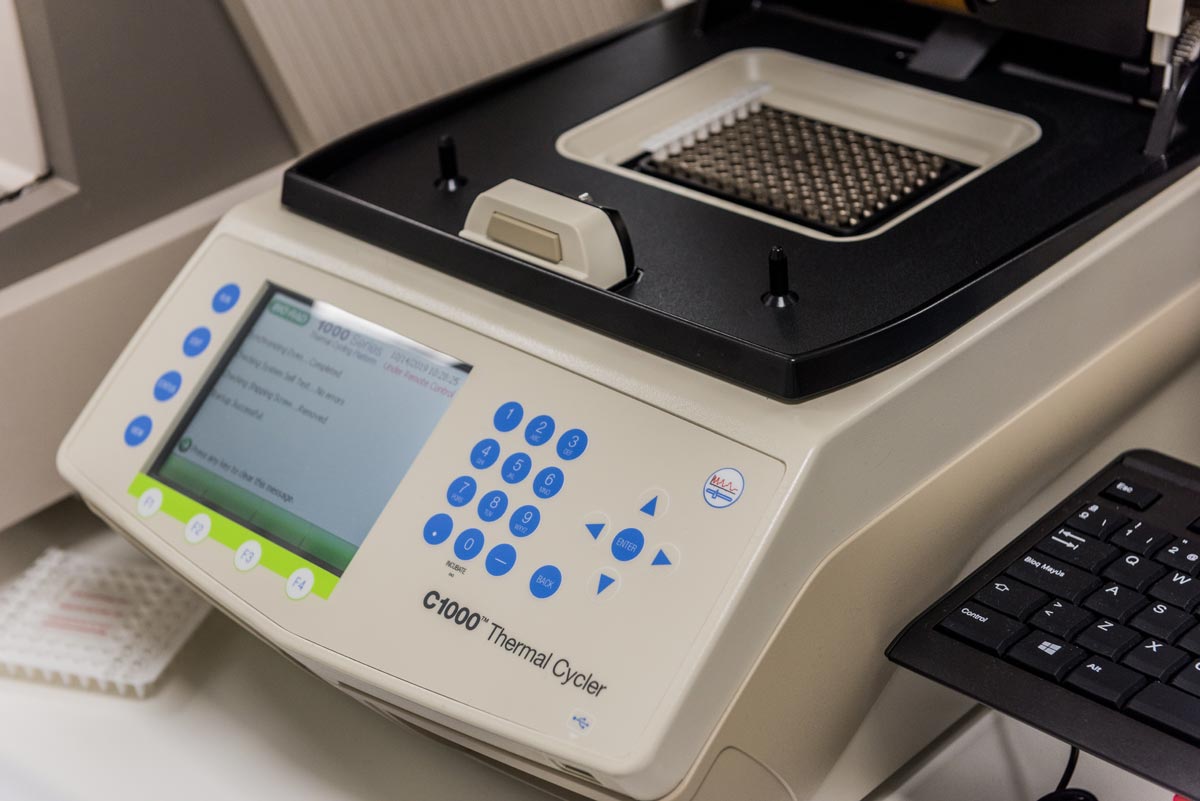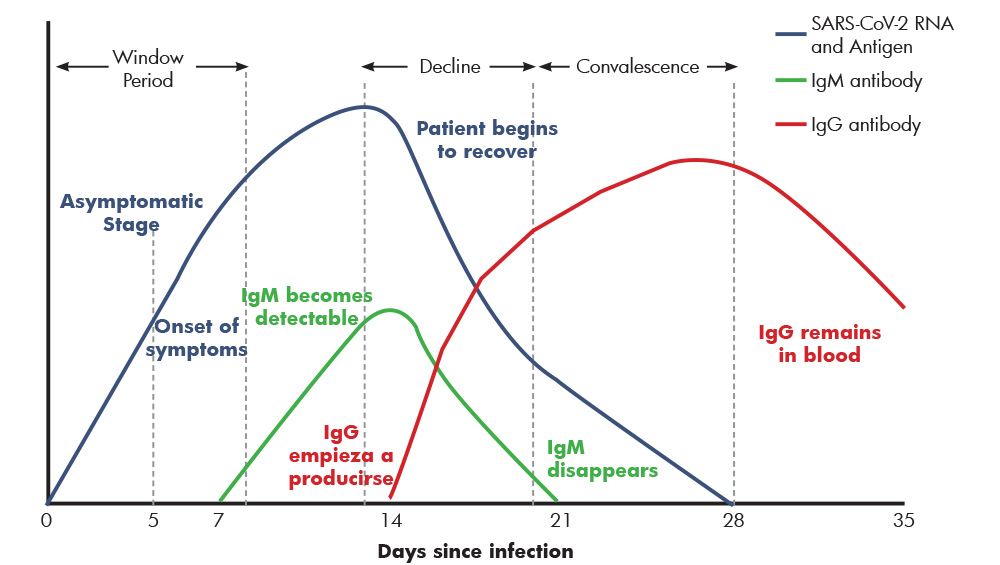 Having tools for a quick diagnosis of cases is essential to: identify, isolate and treat affected patients and thus contribute to mitigating the spread of the disease.
Having tools for a quick diagnosis of cases is essential to: identify, isolate and treat affected patients and thus contribute to mitigating the spread of the disease.
The HC Marbella laboratory, led by our microbiologist Dr. Marco Antonio Sempere Alcocer, has already implemented the reference diagnostic technique by RT-PCR since 11/03/2020.
The availability of PCR results on the same day allows rapid detection of cases, which is complemented by imaging techniques performed in our own center and medical and pharmacological advisory, enabling HC Marbella to offer a comprehensive diagnosis and care of COVID19 in less than 24 h.
Currently, there are 2 different types of diagnostic tests that provide information on the different phases that a patient infected by SARS-CoV2 may encounter:
- Test that detects the presence of virus in the patient, called Direct tests.
- Test that shows that a patient has been infected through antibodies that he has created against the virus, called Indirect tests.
The HC Marbella laboratory has both techniques in its own facilities, making it possible to carry out an effective diagnosis in less than 24 hours, in order to assess, inform, treat and isolate its patients early.
Detection of SARS-CoV2 RNA in respiratory samples is the reference and choice technique for the microbiological diagnosis of COVID-19.
Advantages
- It is the one with the highest sensitivity and specificity to detect the presence of viruses.
- Viral RNA can be detected two days before symptoms appear; after the first symptoms, the viral load increases progressively in the acute phase, to subsequently decrease and become undetectable after 14-21 days.
- In clinically severe cases, the PCR can remain positive for up to 30 days.
- It allows to detect the presence of asymptomatic patients.
- Confirms virus clearance in patients who have had COVID-19.
Inconvenient
- It is a laborious technique and a laboratory equipped with a level 2 Biosafety room, special equipment and specialized staff is needed.
Direct detection of antigens in a respiratory sample is performed using an Antigen-Antibody reaction.
Inconvenient
- Poor diagnostic sensitivity (less than 50% of patients are detected than if they have the virus).
The HC Marbella laboratory has opted from the outset for the RT-PCR reference technique.
To ensure the highest sensitivity of RT-PCR and avoid false negatives:
- We opted to detect 3 targets of the SARS-CoV2 genome, in order to limit the possible changes that the virus may produce in its continuous evolution (preventing some mutations from affecting the diagnostic capacity of PCR).
- As the diagnostic profitability depends to a great extent on how the sample is taken, the nursing team is perfectly trained and has the appropriate knowledge, so that it is done correctly.

It is currently the rapid technique that presents greater sensitivity and specificity and is proposed as a solution to detect cases of past infection and for cases in evolution of more than a week.
The presence of IgM occurs between 7-10 of the onset of symptoms, and usually decreases after 20 days, until it disappears. IgG becomes positive from 14-20 days and is usually maintained for a long time.
Therefore, diagnosis of COVID19 infection based on serological testing will in most cases only be possible in the recovery phase, when many of the opportunities for clinical intervention or interruption of disease transmission have already passed.
Advantage
This Immunoglobulin kinetics could theoretically be useful to indicate what stage the patient is in, once they get the disease.
Inconvenient
- The main drawback is that it does not serve as an early diagnosis since it becomes positive from the 7th-14th day of having symptoms.
- The FDA warned of the possibility of false positives from diseases previously passed by other types of Cornavirus.
- Not all individuals produce the same antibody response after a coronavirus infection, which may take longer to occur and may not occur with the same intensity, and may give false negatives. This could be due to patient factors such as age, nutritional status, certain medication, HIV patients, immunosuppressive status of the patient, severity of the disease, etc.
Although the reference technique for identifying and confirming COVID-19 cases remains RT-PCR, antibody detection may be useful for epidemiological purposes and in some cases for acute infection.
HC Marbella offers the performance of these serological tests, previously evaluated, to determine IgG and IgM and provide complementary information to the direct detection of the virus by RT-PCR. The combination of PCR and serological tests can provide an overview of the phase of the process in which the patient may be.
With the combination of PCR and serology we will be able to classify patients according to the risk of infection by SARS-COV2:
- Infected patient: positive PCR
- Risk patient: negative PCR and negative IgG
- Possibly immunized patient: negative PCR and positive IgG
It should be noted that the interpretation of serological tests must be carried out with caution. taking into account its limitations, and evaluate them according to the patient’s clinical situation and the results of the RT-PCR reference test. Although the presence of IgG seems to indicate immunization against reinfection against the virus, there is still no scientific evidence to confirm this for sure.

| PCR | IgM | IgG | INTERPRETATION |
| – | – | – | Negative – Not Immunized – Patient at risk |
| + | – | – | Preclinical or clinical phase less than 7 days |
| + | + | – | Acute phase of infection 7-10 days |
| – | + | – | Active phase of more than 7-10 (decreased viral load). Repeat PCR. |
| – | + | + | Active phase of more than 14 days (decreased viral load; good IgG prognosis) |
| + | + | + | Active phase of infection (possible good prognosis for IgG) |
| + | – | + | Final phase – Infection of more than 14 days (or possible recurrence) |
| – | – | + | Past infection and healed |
Dr. Marco Antonio Sempere Alcocer
Microbiology and Parasitology Specialist
April 11, 2020
Read other news
Online appointment and download of test results through My HC.
Tel.: +34 952 908 628
952908898 Oncology
951829978 Diagnosis by imaging
951829947 Gynecology
952908897 Fertility
951829947 Physiotherapy